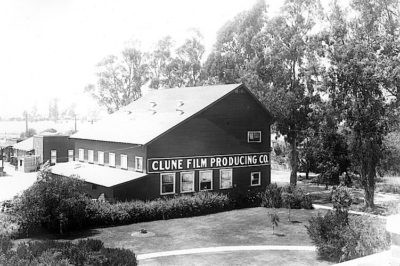Cisco Kid ‘was a friend of mine,’ and other recollections . . .

WHEN RALEIGH Studios on Melrose Ave. was Clune Studio in 1916. Photo from Bison Archives.
The west side of Raleigh Studios, facing Bronson Avenue between Clinton and Melrose, never fails to fascinate. I walk by it in the early morning and admire its tongue-and-groove construction (though there is some stucco on the section just north of Clinton) and its intriguing fenestration: 31 windows on the upper story and 40 on the lower. Some are sash windows; others casement; some are double and one is a jalousie — louvered. It’s an architectural fabric woven over the last 100 years.
The wall is painted barn red tilting toward terra cotta, and I can almost see this building a century ago, when film studios were barnlike and quickly built on what was farmland a moment before. And so it was with what is now known as Raleigh.
W.B. Brown, who was also an insurance man, sold his farm to Adolph Zukor and the Famous Players Fiction Studio in 1915. But Zukor’s co-producer Charles Frohman went down with the “Lusitania” that same year; Zukor then sold the studio to William H. Clune, a Los Angeles theater owner.
(Zukor soon joined forces with Jesse Lasky and formed Famous Players-Lasky, which became the nucleus of Paramount.)
Clune Studios
The first film Clune shot at the Melrose studio was “Ramona,” based on the 1884 novel by Helen Hunt Jackson, a plea to protect the rights of California’s virtually enslaved Mission Indians.
With the coming of talkies, Clune partnered with Tec Art Studios, of New York, to rebuild the studio. Construction began in 1926 with new sound stages. The Disney brothers founded their recording company here in 1929, adding a sound theater and a postproduction facility.
My husband’s uncle
Over the years, many producers leased the lot, beginning with Douglas Fairbanks in 1919–1922. Among them was a larger-than-life uncle of my husband, Bill Linsman: Philip Krasne, from Nebraska.
In 1952, “Billboard” announced that Gross-Krasne (Jack Gross was Phil’s business partner) had bought California Studios, one of 5300 Melrose’s many on-site operators, giving Gross-Krasne full control of the property and making it the first television company to have its own lot. Bill and his cousin Jim recall going to the studio, at not yet 10 years of age, to watch construction — set building, perhaps.
Phil Krasne produced B films and a great many television programs. He is especially known for “The Cisco Kid,” with Duncan Renaldo and Leo Carrillo. Phil was a lawyer by training, and among the first in the industry to realize that syndication would be profitable. Television was still new.
The Clune family retained ownership of the land and buildings until 1979 — and a fast-moving train of producers and directors and stars passed through the now 11-acre complex before the Clunes sold it.
Pioneertown
Phil Krasne was also one of the men behind Pioneertown, 125 miles from Hollywood, in the high desert east and north of Joshua Tree National Park. Pioneertown at that time was a small village that was transformed into a set for westerns, replicating a rough-and-ready 19th-century town.
Stories vary, but Roy Rogers, Gene Autry, and others are credited with the development of the “town.” Phil was quoted a few years ago by writer John Huff as disputing Autry’s participation.
Rogers invested and owned land, Phil said, but never used the location for his own productions. (There was a real motel, though, with 20 rooms, so crews could have a place to carouse and sleep.) Phil was an enthusiastic user of Pioneertown. “The Cisco Kid” was filmed there.
Now the young and the hip are in residence there — yet another life for Pioneertown.
Fake town becomes real, a young man comes in on a train from Nebraska to a debate competition and makes an O. Henry character on the page a success on the small screen: It’s such a Hollywood story.
By Paula Panich
The author thanks noted Hollywood historian Marc Wanamaker for providing information for this column.
Category: Real Estate


